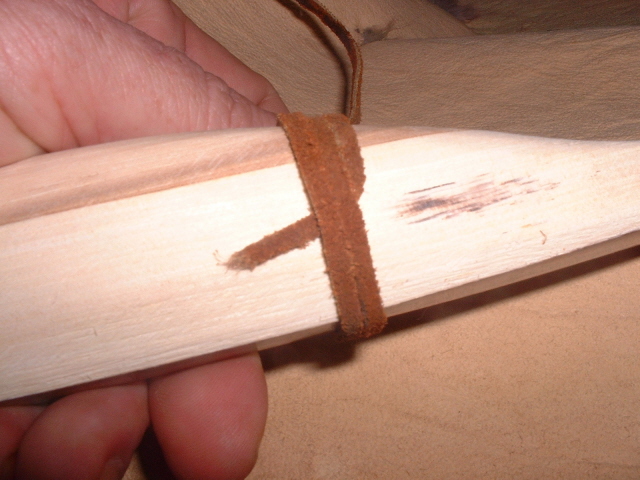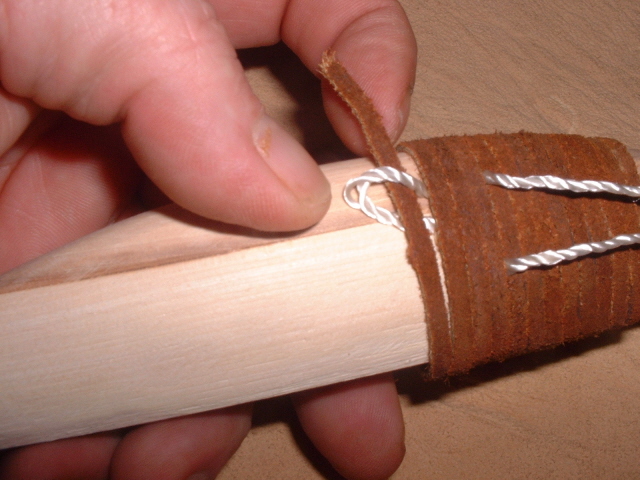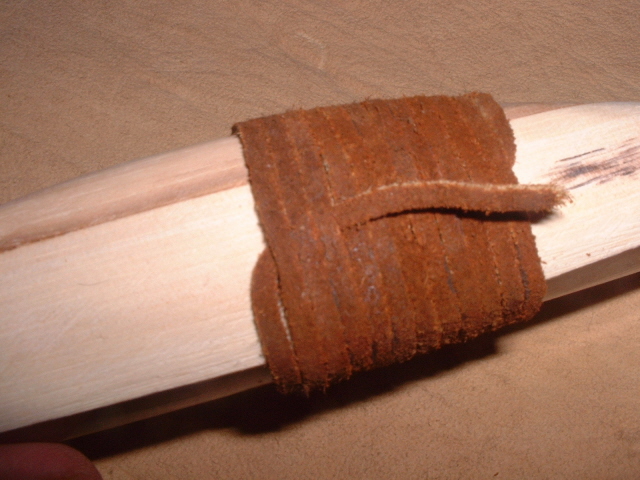
There are basically two types of leather grips I put on my bows. The “wrapped grip” and the “stitched grip”. I usually complete the bow through tillering and shooting. I also already have the leather arrow shelf glued on and shaped if that’s the style I’m using. If you’re shooting off the knuckle or have another choice for a shelf then proceed as shown. I’ll address the installation of both styles in the following tutorial.

The “wrapped” style grips are just as the description implies. That is to say the grip area of the bow is “wrapped” around the bow with leather lacing or a leather strip. I prefer leather lacing that can be purchased at most any leather or craft store and comes in a variety of weights and colors. I keep several colors on hand depending on the type or style of bow and whether I have dyed the bow and need a color to match.
To begin take some Barge’s, rubber or contact cement and apply to the approximate area of the bow’s handle you want the wrap to extend. Begin wrapping by laying about 1/2” of lace parallel to the length of the bow and wrap the lace around the bow overlapping the tag you began with. I start the wrap at the top of the grip and on the opposite side of the palm.

Continue wrapping tightly around the handle until you are approx ½” to ¾” from where you want it to end. Take a short length of strong string (about 6-7” works well) and lay a loop down on the same side you started the tag end on. Continue wrapping over the loop until you get to where you want the wrap to end. This should leave the loop of string exposed out the bottom edge of the grip.

Insert the end of the lacing into the loop and pull through the overlapping lace. Work it back and fourth slowly until it emerges from under the wrap and trim off the tag end. If it is short enough, just pull until it is secured under the wrapping and the loop pulls free. Now you can use the back of a spoon to compress and adjust the wrapping as needed before the cement sets completely. Enjoy your new leather grip.


The stitched grip is done by using a one piece leather piece surrounding the handle and stitched up the back of the bow. Once again I also already have the leather arrow shelf glued on and shaped if that’s the style I’m using. If you’re shooting off the knuckle or have another choice for a shelf then proceed as shown.
Measure off and cut the piece of leather material you intend to use for your grip. I like to use thinner weight leathers because you get a nice tight fit when you stitch them on the back of the grip. Heavier weights can be used but the butt seam must be really good to get a nice fit. I like at least a 4 ½” grip because I usually “palm” my bows when I shoot and also have big hands. I cut the length approx ¾” longer than my intended grip and wide enough to wrap around the handle with excess material left. The extra length is so you can roll the edges for a nice finished edge at the top and bottom. Apply some “barge’s” cement along the top and bottom edge approx ½” wide. Roll the top edge down approx ½” and press together. Roll the bottom edge up approx ¼” and press together. I cover the exposed surface with wax paper and se a heavy book on it for an hour or so. While that is setting up lets get our other materials together so we can begin the installation process.
You will need the following:
|
1) |
At least one needle preferably two and Glover’s needles if you have them. |
|
2) |
Artificial sinew, real sinew, nylon thread or some other suitable mater for stitching. |
|
3) |
A leather punch, awl or other means for making SMALL dia holes along the edges of the leather. |
|
4) |
Optional, several spring clamps. |
|
5) |
A ruler or straight edge. |
Begin the installation by placing a small bead of cement along each side of the handle. Be sure to use a small amount of glue as you will be removing the grip at a later phase. Position the leather in place on the bow and wrap the leather up the sides to the back and pinch and stretch the leather with the spring clamps.
After this has set for a while (a couple of hours) remove the clamps and trim the excess to where it just overlaps at an imaginary center down the back of the handle. Take your straight edge and lay down the center of the back. Here you can do it two ways. You can cut through both layers of leather at the same time or you can mark and cut one and use the cut edge as a guide for the other side.
Once trimmed you can either remove the grip to punch the holes or you can mark and punch the holes while it’s on the bow. If you were to have chosen to do it on the bow, additional cement should have been applied to permanently secure the leather. I like to secure mine permanently and use a squeeze punch to put in my holes.
Mark the location of the holes on the inside of the leather evenly spaced along the edge and approx 1/8” in from the edge. Punch the holes in their locations on each side. Take your stitching material and pull off approx 28” or so. I like to wax mine using bee’s wax. Thread your needles and begin your stitching. Start at the top row of holes and go from the outside in, across to the other hole and inside out. You should now have a length of material running from inside to out. Do this again to double the first stitch into a loop. Take the needle on the left and come over the left side and up through the hole on the right. Do the same with the right side…come over the right edge under and through the hole on the left. You should now have a “V” stitch with the ends coming from the inside out on each side. Repeat this all the way to the end and out the last row of holes.
Important: Leave the stitches loose until you have gone the full length of the grip. Now go back and using a nail or awl or similar device, begin to tighten the stitches as you work your way down. Careful not to pull to hard or you could rip out a stitch and have to start over. This is where the stretchy thinner leather comes in handy. As you work your way down to the end, double the last stitch as you did on the first with the stitching material coming out from the bottom underside on both tag ends. Take the end and tie them off leaving enough to burn the ends so they won’t unravel. Tuck the knot up under the grip and admire your handiwork.
Take care.. Sparky

Trad Gang.com
Stickbow.com
Primitive Archer

